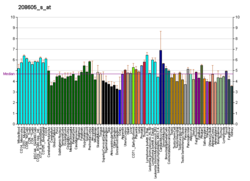Tropomyosin receptor kinase A (TrkA),[5] also known as high affinity nerve growth factor receptor, neurotrophic tyrosine kinase receptor type 1, or TRK1-transforming tyrosine kinase protein is a protein that in humans is encoded by the NTRK1 gene.[6]
This gene encodes a member of the neurotrophic tyrosine kinase receptor (NTKR) family. This kinase is a membrane-bound receptor that, upon neurotrophin binding, phosphorylates itself (autophosphorylation) and members of the MAPK pathway. The presence of this kinase leads to cell differentiation and may play a role in specifying sensory neuron subtypes. Mutations in this gene have been associated with congenital insensitivity to pain with anhidrosis, self-mutilating behaviors, intellectual disability and/or cognitive impairment and certain cancers. Alternate transcriptional splice variants of this gene have been found, but only three have been characterized to date.[7]
- ^ a b c GRCh38: Ensembl release 89: ENSG00000198400 – Ensembl, May 2017
- ^ a b c GRCm38: Ensembl release 89: ENSMUSG00000028072 – Ensembl, May 2017
- ^ "Human PubMed Reference:". National Center for Biotechnology Information, U.S. National Library of Medicine.
- ^ "Mouse PubMed Reference:". National Center for Biotechnology Information, U.S. National Library of Medicine.
- ^ Malenka RC, Nestler EJ, Hyman SE (2009). "Chapter 8: Atypical neurotransmitters". In Sydor A, Brown RY (eds.). Molecular Neuropharmacology: A Foundation for Clinical Neuroscience (2nd ed.). New York: McGraw-Hill Medical. ISBN 9780071481274.
Another common feature of neurotrophins is that they produce their physiologic effects by means of the tropomyosin receptor kinase (Trk) receptor family (also known as the tyrosine receptor kinase family). ...
Trk receptors
All neurotrophins bind to a class of highly homologous receptor tyrosine kinases known as Trk receptors, of which three types are known: TrkA, TrkB, and TrkC. These transmembrane receptors are glycoproteins whose molecular masses range from 140 to 145 kDa. Each type of Trk receptor tends to bind specific neurotrophins: TrkA is the receptor for NGF, TrkB the receptor for BDNF and NT-4, and TrkC the receptor for NT-3.However, some overlap in the specificity of these receptors has been noted. - ^ Martin-Zanca D, Hughes SH, Barbacid M (April 1986). "A human oncogene formed by the fusion of truncated tropomyosin and protein tyrosine kinase sequences". Nature. 319 (6056): 743–8. Bibcode:1986Natur.319..743M. doi:10.1038/319743a0. PMID 2869410. S2CID 4316805.
- ^ "Entrez Gene: NTRK1 neurotrophic tyrosine kinase, receptor, type 1".





